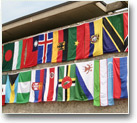An Installation in a college or university setting is the official ceremony where the President is formally endowed with the powers and responsibilities of office. The ceremony provides the opportunity for the new President to share their vision for the university during their term of office.
An installation is often called Convocation, using the traditional meaning of the word: “a ceremonial assembly of members of a college or university.”
University installation ceremonies vary with the institution and there are many traditions associated with the ceremony, such as: wearing academic regalia, procession of academic dignitaries, official greetings, bestowing the ceremonial robe of office, the presence of representatives from various constituencies (other universities, staff, students, alumni, etc.), passing of a symbolic artifact such as a chain of office, mace or charter, display of a university seal or coat of arms and ceremonial music. Trent’s Installation 2014 will honour many of those traditions.
Academic Regalia
Academic regalia is derived from the costume worn by monks and students in the thirteenth and fourteenth centuries when long robes and cowls were used for protection from the cold in drafty rooms and corridors. The various colours of the gowns and goods today represent the degree held by the wearer and the institution awarding it. The faculty wear the regalia of the institution of their highest degree.
The Procession
Dressed in their regalia, the faculty, Board of Governors, Members of Senate, dignitaries of other Universities and other dignitaries form an academic procession. In the Installation of a President, it is tradition to invite the Presidents of other Universities who process in the order in which the University was founded.
Investiture
The President is divested of the robes pertaining to their current status (academic, honorary graduate robes) and invested with the robes of the office of President.
The Condolence Cane
A gift to the University from the Trent Aboriginal Education Council, this replica Cane was carved by the late Chief Jake Thomas of the Cayuga Nation, who was also a Trent Professor. It is a symbolic representation of the governance structure of the Haudenosaunee (People of the Longhouse). For Trent, the Cane represents the academic governing power of the Senate, the interdependent nature of the University community, and the search for knowledge in the interests of justice, equality and peace. Traditionally, the Condolence Cane is used by the Haudenosaunee as a mnemonic device depicting the “seating” arrangement and relationships of the Grand Council Confederacy Chiefs in the Nations and clans of the Six Nations. Each Chief’s title is represented by a peg and a pictograph depicting aspects of the title or the story of each title holder. The Peacemaker’s mission was to put an end to war and to create unity through bringing Good Minds together to work for peace. His efforts resulted in the founding of the Haudenosaunee Confederacy. The story of the Journey of the Peacemaker, with its many attendant teachings including the Condolence, is one of the foundational representations of The Great Law of Peace, the Constitution of the Haudenosaunee Confederacy.
The Honour Song
In accordance with Aboriginal tradition, an honour song will be performed for the President.






























